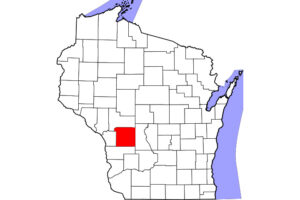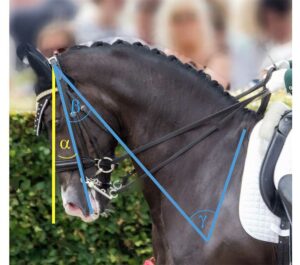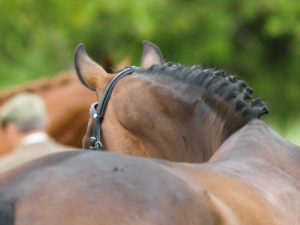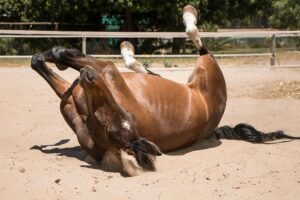The Power of Equine Laser Therapy
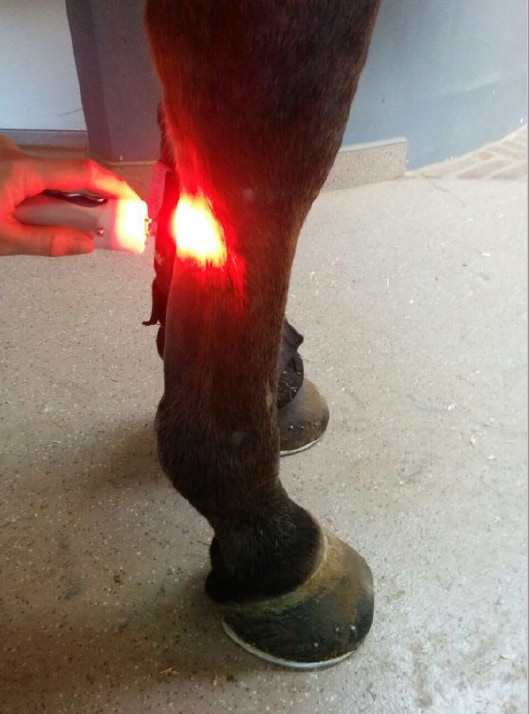
Class IV laser therapy offers promise for improved healing
The chances for recovery from tendon and ligament injuries that were once career-ending are improving, thanks to a wide range of regenerative therapies brought from human medicine into equine rehabilitation. However, tendon healing still takes a long time, and the re-injury rates remain high.
Physiotherapists have been using laser therapy technology in people for nearly 40 years. It has become a routine part of treatment to provide pain relief and healing in humans and is increasingly used to encourage healing in horses.
Martha Rodgers, VMD, owner of Shephard Hill Equine, in Lexington, Kentucky, uses a Class IV laser regularly to treat muscle injury or soreness, tendon and ligament injuries, and wounds. In one recent case a Thoroughbred sales yearling had a 30-by-40-centimeter (an almost 12-by-16-inch) laceration to his pectoral area two months before a sale. The triangle-shaped flap of skin was devitalized and had to be excised. Just four days after the injury Rodgers began a series of high-power laser treatments.
“Within three weeks the wound was nearly healed,” she says. “It had reduced to a 10-by-10-centimeter area that was rapidly epithelializing and contracting, and he successfully went into the sale with only a small scar.
“When it comes to wound healing, the earlier in the process Class IV laser treatment is started the more profound the healing,” she adds.
When researcher Mathilde Pluim, PhD, a faculty member at Ghent University, in Belgium, first encountered high-power laser therapy in horses, little concrete data on the therapy existed, and the evidence at that point was clinical (i.e., not yet supported by controlled, peer-reviewed published research) and anecdotal. She and other researchers are committed to changing that. Recent study results are confirming high-power laser therapy significantly improves short- and long-term healing of tendon and ligament lesions, creating an exciting option for treating these soft tissue injuries.
“For equine orthopedics, it is interesting to explore therapeutic options … that were already successfully being applied in human orthopedics,” she says.
Here’s what you need to know about Class IV laser treatments, the current research, and opportunities for further advancement.
Understanding Laser Therapy
The word laser is an acronym for light amplification by stimulated emission rays (radiation). Many types of lasers, from presentation pointer aids to restorative models, exist. Used therapeutically, a laser sends concentrated, focused light waves into the horse’s body.
Lasers are grouped by wavelength, output power, and emittance mode, ranging from Class I to Class IV. In general, light treatment increases blood flow and lymphatic drainage and triggers cell processes that promote healing.
Specifically, focused high-power laser light encourages cell signaling by recruiting white blood cells from the circulation and other tissues and activating those cells already present at the injury or wound site. One of the primary benefits of light therapy is vasodilation, which allows more biochemical factors released by cells in the treated area to reach the bloodstream, Rodgers explains.
What makes Class IV laser therapy different from lower-level light therapies is it uses a longer wavelength, she says. Infrared light penetrates mere millimeters of the skin, whereas a high-power laser can reach between 1 and 8 centimeters, depending on the laser’s wavelength.
“Specific, focused wavelengths is what gives Class IV laser therapy the ability to more deeply penetrate the tissue,” Rodgers says. “Different types of lasers depend on the crystal and/or gas used to create the wavelength of laser light. For example, my treatment laser uses GA-Al-As (gallium-aluminum-arsenate) that emits two wavelengths, 800 and 970 nanometers (nm).”
The authors of the 2020 study “The Beneficial Effects of High-Intensity Laser Therapy (HILT) and Co-Interventions on Musculoskeletal Pain Management: A Systematic Review,” reported that “the main difference between HILT and low-power laser therapy is that the more powerful beams (power > 500 mW) are irradiated to penetrate deeper, bringing a desired high amount of multidirectional energy to deep tissues in a short time.”
Scientific Studies
In 2017 Pluim led a retrospective study examining how 150 sport horses diagnosed with tendon or ligament injuries responded to high-power laser therapy. The findings showed significant healing.
After just two weeks of high-power laser therapy, she and her team noted a significant improvement in study horses’ lameness and lesions’ ultrasonographic appearance. Also, the long-term outcome after six, 12, and 24 months was good. Due to the accelerated healing process, the rehabilitation protocol after laser therapy could be shortened, and often horses were back to their previous performance level after four to six months (TheHorse.com/162321).
Those results spurred her next study published in 2020, which included 12 Warmbloods that each had four lesions on their lateral suspensory ligament branches. Two lesions were treated with a multifrequency high-power laser daily (for 20 minutes at four wavelengths ranging from 635 to 980 nanometers) for four weeks. Two to three months after treatment, ultrasound showed lesions were significantly smaller in horses treated with laser therapy than in control group horses. On an MRI, lesion circumference and cross-sectional area were also significantly smaller in treatment horses than controls (TheHorse.com/195661).
“Results of our studies suggest that high-power laser therapy improves healing of tendon and ligament injuries in horses, if applied with the device and protocol described,” Pluim says. “Now that there are solid studies available describing the effects of high-power therapy in tendon and ligament injuries in the horse, we can define it as evidence-based medicine.”
Paulina Zielinska, DVM, and a team of scientists at the Wrocław University of Environmental and Life Sciences, in Poland, have also expanded the body of data on horses receiving high-power laser treatments. In their 2020 study they divided 26 Warmbloods diagnosed with tendon and ligament injuries into two groups: one that received a series of 15 HILT treatments and one that did not. Horses receiving HILT were treated with two infrared wavelengths concurrently of 808 and 980 nm. All horses received 20 minutes of daily hand-walking and cold water therapy over a 40-day period.
“The introduction of laser therapy to veterinary medicine, particularly to analgesic (pain-relieving) therapy in horses, gives hope of improving the quality of life of patients with chronic musculoskeletal pain,” the researchers wrote.
Class IV Laser Therapy Applications
Veterinarians can use Class IV laser anywhere on the horse’s body to address muscle soreness, tendon and ligament injuries, and superficial wounds and post-surgical sites, says Rodgers. “I use it in cases where I’m trying to increase blood flow to the area to encourage healing,” she explains. “If being used around the eyes, the horses will need some sort of eye protection, but other than that it is safe to use from nose to hoof to tail.”
She has also performed high-power laser treatments on mares with repeated reproductive loss alongside acupuncture and other modalities to increase blood flow to the uterus. Other veterinarians are using it for penile and vulvar injuries.
“I also use it on horses with arthritic joints as part of a larger program,” she says. “The laser can’t reverse the changes that have occurred but can help manage the fibrosis (scarring) or stiffness around the joint.”
One successful case Rodgers cites is that of an 8-year-old event horse diagnosed with a proximal hind-limb suspensory injury. Six weeks after diagnosis, ultrasound revealed the desmitis was unchanged with stall rest, and the horse was still at the same level of lameness. The owners opted against biological cell therapies but agreed to six sessions of high-power laser therapy.
“We repeated his ultrasound at four weeks, and he had about a 60% improvement in infiltration of cells and cellular materials in the suspensory defect,” Rodgers says. “His lameness had also improved significantly. He went back to competing at his previous novice level within nine months and continued to compete into his teens.”
The modality’s noninvasive nature is what made it attractive to this horse’s owners and many others. However, if applied incorrectly, a high-power laser might lead to skin burns or discoloring of the hair, says Pluim.
“Also, if the dose, wavelength, or treatment duration are not correct, there might not be an effect on the aimed tissue at all,” she adds.
Rodgers notes that Class IV laser therapy can be used in conjunction with platelet rich plasma and stem cell treatments to increase the activity of growth factors in those therapies.
“Laser therapy does require more time; treatments last between 8 and 20 minutes,” she adds. “Most horses tolerate it well, and sedation is not needed—an advantage over other treatment options.”
Take-Home Message
“The market of (high-power) laser therapy is growing rapidly, which makes this type of therapy more widely available in the recent years,” says Pluim. “This is a great development; however, caution should be taken when comparing different devices and treatment protocols. Also, a proper diagnosis is necessary for successful treatment outcome.”
“Class IV lasers are a therapeutic device with thermal, biochemical, and bioelectric effects,” Rodgers says. “But if we don’t address the injury in terms of other factors like hoof balance, overuse, or terrain, then the long-term results for preventing re-injury won’t be as good. Laser therapy is just part of an overall treatment plan for the horse.”
While researchers have shown Class IV laser therapy increases blood flow and cellular activity, which can shorten healing times, Rodgers cautions that injured tendons and ligaments still need adequate rehabilitation to repair tissue strength and elasticity to avoid re-injury.
[/et_pb_text]
Written by:
Katie Navarra
Related Articles
Stay on top of the most recent Horse Health news with










